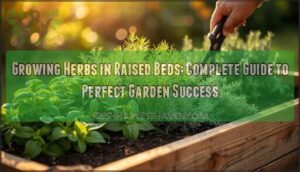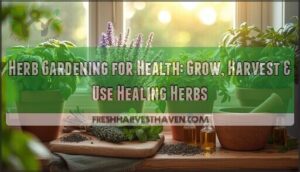This site is supported by our readers. We may earn a commission, at no cost to you, if you purchase through links.
 Growing herbs in raised beds lets you play garden architect with complete control over soil, water, and sunlight—kind of like running your own culinary laboratory just outside your door.
Growing herbs in raised beds lets you play garden architect with complete control over soil, water, and sunlight—kind of like running your own culinary laboratory just outside your door.
You’ll dodge the soggy feet problem that plagues herbs in heavy soils, while neat rows mean no more scavenger hunts for runaway mint.
Just fill your bed with quality soil, plant your favorites, and enjoy easy access for snipping fresh herbs on a whim.
Growing herbs in raised beds makes it simple, tidy, and productive—even for first-timers.
Stick around, because there’s a world of tricks that can make your harvest shine.
Table Of Contents
- Key Takeaways
- Raised Bed Basics
- Selecting Herb Varieties
- Preparing Raised Bed Soil
- Planting and Maintaining Herbs
- Growing Herbs Year Round
- Frequently Asked Questions (FAQs)
- Do herbs grow well in raised beds?
- Which herbs grow best in raised garden beds?
- Can you grow herbs in a raised garden bed?
- Is Basil suitable for growing in a raised bed?
- What is a raised bed herb garden?
- How tall should a raised bed be for herbs?
- Can a raised bed herb garden elevate your cooking?
- How do you protect herbs from frost?
- What are the best mulch options for herbs?
- Can herbs grow well in partial shade?
- Conclusion
Key Takeaways
- You’ll get better drainage, warmer soil, and easier access for snipping fresh herbs when you grow them in raised beds.
- Picking the right bed dimensions (about 3-4 feet wide and 8-12 inches deep) helps roots grow strong and keeps you from compacting the soil.
- Mixing annuals and perennials lets you harvest fresh flavors all season; pick herbs that match your kitchen habits and climate.
- Good soil—rich in organic matter, with balanced pH and proper drainage—makes all the difference for healthy, productive herbs.
Raised Bed Basics
You’ll create a thriving herb garden when you understand the fundamental principles of raised bed construction and design.
Building the right foundation with proper dimensions, height, and materials sets you up for years of successful herb cultivation.
Optimal Width and Length
Choosing the right bed size transforms your herb garden into a productive paradise.
For raised garden beds, stick to widths between 3-4 feet when accessible from both sides. This raised bed design guarantees you’ll reach every plant without stepping on soil.
Standard 4×8 garden layout design works perfectly, matching lumber sizes while optimizing plant spacing and soil depth for thriving herbs.
The vital bed size is essential for avoiding soil compaction issues and ensuring healthy root growth and a productive paradise.
Ideal Height for Herbs
Most herbs thrive in raised beds measuring 8-12 inches deep, providing adequate soil depth for healthy root development.
Give your herbs room to breathe with 8-12 inches of depth for thriving roots.
This herb height accommodates basil, oregano, and thyme perfectly.
Deeper beds benefit Mediterranean herbs with extensive root systems, while shallow-rooted varieties like cilantro flourish in shorter raised garden beds, and proper plant spacing in your herb garden design guarantees maximal growth.
Choosing Raised Bed Materials
Material selection makes or breaks your raised bed gardening success, so don’t cut corners here.
The right bed frames protect your soil for herbs while managing drainage systems and material costs effectively.
- Wood Options: Cedar and redwood resist rot naturally, while pressure-treated lumber offers budget-friendly durability
- Soil Quality: Non-toxic materials prevent chemical leaching that could compromise your herb garden design
- Drainage Systems: Proper materials guarantee excellent water flow, preventing soggy roots in your garden beds
When designing a raised bed, consider the optimal bed size to maximize space and herb yields.
Selecting Herb Varieties
You’ll want to choose herbs that match your cooking style and growing conditions.
Consider mixing perennial herbs like rosemary and thyme with annual favorites such as basil and cilantro for a well-rounded herb garden that provides fresh flavors throughout the seasons.
Perennial Herbs
Perennial herbs return year after year like faithful garden companions.
These hardy performers include rosemary, thyme, oregano, sage, and lavender.
Their Root Development creates strong foundations that withstand winter conditions based on Plant Hardiness zones.
You’ll enjoy varied Leaf Texture from silvery sage to needle-like rosemary.
Herb Diversity adds beauty while guaranteeing continuous harvests for your raised bed gardening success.
Annual Herbs
Annual herbs complete their full life cycle in one growing season, making them perfect candidates for succession planting in your raised beds.
You’ll plant from seed, harvest throughout the growth stages, then replant for continuous production.
Here’s your annual herb strategy:
- Seed Selection: Choose fast-growing varieties like basil, cilantro, and dill that mature quickly in raised beds
- Soil Temperature: Plant warm-season annuals when soil reaches 65°F for ideal germination
- Annual Harvest: Cut stems regularly to encourage bushier growth and extend your harvest window
- Herb Pruning: Pinch flowers to keep leaves tender and flavorful longer
Culinary Herbs
Building your culinary herb collection starts with selecting varieties that pack maximum flavor punch.
Basil, oregano, thyme, and rosemary form the backbone of most kitchens, offering diverse flavor profiles for countless dishes.
These aromatic herbs thrive in raised beds, creating fresh spice blends and herbal teas.
Plant parsley, chives, and cilantro for everyday cooking essentials that transform ordinary meals into culinary adventures.
Fragrant Herbs
Why settle for herbs that only taste good when you can grow aromatic plants that smell amazing too?
Fragrant herbs like lavender, rosemary, and lemon balm transform your raised bed into a natural aroma therapy garden.
These scented flowers and fragrant leaves release delightful herb scents when brushed against, making your herb garden ideas come alive.
Perfect for container herb gardening, these herb varieties offer dual benefits for cooking and relaxation.
Preparing Raised Bed Soil
Creating the perfect soil foundation sets your herb garden up for thriving growth throughout the season.
You’ll need to balance drainage, nutrients, and pH levels to match what most herbs naturally prefer.
Soil Composition
Foundation matters when you’re crafting the perfect growing environment for your herbs. Quality soil composition directly impacts plant health, nutrient absorption, and harvest yields. Your raised bed needs the right balance of components to support thriving herb growth throughout the growing season.
The right soil blend transforms ordinary herbs into flavor powerhouses that thrive season after season.
Using an organic soil mix is essential for creating a fertile ground.
- Organic matter: Compost and aged manure improve soil structure and provide slow-release nutrients for sustained herb growth
- Soil pH balance: Most herbs prefer slightly alkaline conditions between 6.0-7.0 for ideal nutrient uptake
- Nutrient levels: Balanced nitrogen, phosphorus, and potassium ratios support healthy foliage and essential oil production
- Microbial activity: Beneficial bacteria and fungi break down organic materials, making soil nutrients more accessible
- Fertilizer types: Choose organic options like fish emulsion or kelp meal over synthetic alternatives for better soil health
Drainage Requirements
Proper drainage prevents waterlogged roots that kill herbs faster than drought.
Your raised garden needs soil porosity of 40-60% to balance water retention with drainage systems.
Check the water table level – it shouldn’t sit within two feet of your herb’s root depth.
Install drainage layers using coarse gravel if irrigation management becomes challenging in clay-heavy garden watering conditions.
To achieve ideal growth, consider the importance of soil composition ratios when preparing your raised bed soil.
PH Level Adjustment
Most herbs thrive in slightly acidic to neutral soil between pH 6.0 and 7.0. You’ll need a pH meter for accurate soil testing before planting.
If your garden soil is too acidic, lime addition raises pH gradually. For alkaline conditions, sulfur works best for fertilizer adjustment.
Test twice yearly to maintain proper acidic balance and ideal soil quality. Understanding soil pH levels is vital for achieving the perfect balance for herb growth.
Organic Matter Addition
Once you’ve balanced your soil’s pH, enriching it with organic matter becomes your next priority.
Compost benefits your herb garden by improving soil structure and nutrient retention. Well-aged manure usage adds nitrogen while worm castings provide slow-release nutrients.
Green mulch from grass clippings breaks down gradually, supporting organic herb gardening success through enhanced soil preparation and garden soil health, with the overall goal of achieving slow-release nutrients.
Planting and Maintaining Herbs
Once you’ve prepared your raised bed soil, it’s time to get your hands dirty with the actual planting and ongoing care that’ll keep your herbs thriving all season long.
The key to herb gardening success lies in understanding when to plant, what grows well together, and how to maintain just the right balance of water and nutrients.
Succession Planting
Once you’ve perfected your soil preparation, succession planting keeps your herb harvest flowing continuously throughout the season.
This garden planning technique maximizes your raised bed’s productivity by staggering plantings every few weeks.
- Crop rotation prevents soil depletion while maintaining healthy growing conditions
- Seed starting indoors extends your growing season beyond typical weather limits
- Plant spacing calculations help determine ideal replanting intervals for each variety
- Harvest timing guides when to sow replacement crops for seamless production
Companion Planting
Strategic companion planting transforms your herb garden layout into a thriving ecosystem.
Basil near tomatoes boosts yields by 20%, while marigolds reduce nematodes by 40%.
These beneficial plants create natural pest control through garden diversity.
Mix oregano with basil to cut spider mites by 28%.
Smart herb care includes avoiding fennel, which stunts most companions, and maintaining proper crop rotation for maximum soil health.
Watering Frequency
Consistent watering herbs prevents stress and promotes healthy growth.
Check soil moisture daily by inserting your finger two inches deep into garden soil health.
Most herbs need water when the top inch feels dry.
Drip irrigation systems provide steady moisture without wetting foliage, reducing disease risk.
Water scheduling should account for rainfall impact and seasonal evapotranspiration rates, adjusting frequency accordingly for effective herb garden care.
Understanding the essential watering schedule is vital for maintaining healthy herbs and preventing common issues.
Fertilization Tips
Herbs don’t need heavy feeding like vegetables, but strategic plant nutrition boosts their flavor and growth.
Soil testing reveals what nutrients your garden needs before adding any fertilizer ratios. Light applications work better than overdoing it since too much nitrogen reduces essential oils.
Using an organic fertilizer source can help determine the best approach for your herbs.
- Apply compost tea monthly during growing season for gentle, sustained feeding
- Use organic fertilizers with lower nitrogen content (like 4-4-4) to prevent leaf overgrowth
- Add microbial boosters to improve soil health and nutrient uptake naturally
Growing Herbs Year Round
You can enjoy fresh herbs throughout the year with proper planning and techniques that adapt to changing seasons.
Strategic variety selection and simple season-extending methods will keep your raised bed productive even during winter months, using proper planning and simple methods.
Seasonal Herb Selection
Planning your seasonal herb selection requires understanding when each variety thrives in your climate zone.
Cool-season herbs like cilantro, dill, and parsley flourish during spring and fall when temperatures stay moderate.
Warm-season varieties including basil, oregano, and thyme prefer summer heat.
Consider regional varieties adapted to your area’s specific growing conditions for better success rates and extended harvest timing throughout the gardening season to ensure better success.
Indoor Herb Gardening
When cold weather hits, bringing your herbs indoors keeps fresh flavors flowing.
Indoor gardening transforms garden containers into productive herb cultivation spaces with proper herb lighting and attention to soil temperature.
- Herb Lighting: LED grow lights provide 6-8 hours of daily illumination for aromatic herbs like basil and oregano
- Garden Containers: Self-watering pots with drainage holes prevent root rot while maintaining consistent moisture
- Indoor Pests: Monitor regularly for aphids and spider mites, using organic neem oil treatments when needed
- Gardening Tools: Small pruning shears and moisture meters help maintain healthy growing herbs year-round
Winter Herb Care
Your tender herbs need a helping hand when winter arrives. Start herb pruning in late fall, cutting back perennials like oregano and thyme to prevent winter damage.
Apply winter mulching around herb bases using straw or leaves for insulation. Cold frames work wonders for extending your herb maintenance season.
Snow cover actually protects many hardy herbs naturally, acting as nature’s blanket for winter gardening success.
For superior results, consider implementing proper indoor gardening techniques to guarantee year-round herb growth and ensure winter gardening success.
Extending Growing Season
Your raised bed’s strategic advantages make season extension achievable with smart techniques.
Cold frames and greenhouses create protected microclimates, while frost protection measures safeguard tender herbs during temperature drops.
- Season extenders like row covers trap heat, extending harvests 4-8 weeks beyond normal frost dates
- Microclimate modifications using mulch and windbreaks stabilize soil temperatures for consistent growth
- Garden layout design with protective structures maintains herb garden maintenance through winter months
Frequently Asked Questions (FAQs)
Do herbs grow well in raised beds?
Did you know herbs can yield up to 30% more in well-drained beds?
You’ll love how great drainage, easy access, and fewer weeds make your harvest a breeze—just don’t let your basil outgrow its welcome!
Which herbs grow best in raised garden beds?
If you’re looking to grow herbs that are low-maintenance and reliable, try basil, thyme, sage, parsley, oregano, chives, and mint.
These culinary favorites thrive with good drainage, sun, and a little routine care—no green thumb required!
Can you grow herbs in a raised garden bed?
Absolutely, you can grow herbs in a raised garden bed—even if your thumb’s more brown than green.
These beds offer excellent drainage, warmer soil, and easy access, turning even a beginner’s patch into an herb lover’s paradise.
Is Basil suitable for growing in a raised bed?
Basil thrives when you give its roots space, and that’s just what a raised bed offers.
You’ll get lush, fragrant leaves all season, plus fewer weeds.
Just keep the soil moist, and watch your basil boom!
What is a raised bed herb garden?
A raised bed herb garden is a soil-filled frame sitting above ground, letting you skip rocky soil and pesky weeds.
You’ll have easy access, better drainage, and can reach for that extra mint without wading through mud.
How tall should a raised bed be for herbs?
Did you know herbs grow up to 25% faster in the right conditions?
Aim for a bed height of 8–12 inches—you’ll give roots space to stretch, soil better drainage, and your back fewer complaints.
Can a raised bed herb garden elevate your cooking?
Turning homegrown herbs into your meals is like adding a secret ingredient—freshness you just can’t fake.
You’ll reach for those sprigs more often, boosting flavors and bragging rights without ever leaving your backyard.
How do you protect herbs from frost?
When Jack Frost nips at your garden, cover herbs with frost cloth or old sheets overnight.
Mulch around roots, water before a freeze, and group pots together near a wall for warmth—herbs appreciate a little protection plan!
What are the best mulch options for herbs?
Mulch with straw, shredded leaves, or pine needles to keep roots cool and weeds in check.
Skip heavy wood chips—they trap moisture.
Herbs like to breathe, not suffocate.
Remember, mulch acts like a cozy blanket, not a winter jacket.
Can herbs grow well in partial shade?
Many herbs thrive in partial shade—think mint, parsley, and chives.
You’ll dodge some sunburn, but growth may be slower.
Find that dappled sunlight spot, water consistently, and you’ll still get flavorful leaves for your kitchen.
Conclusion
Apparently, your neighbors will envy your “herb empire,” all because you mastered growing herbs in raised beds.
You’ll skip the wild chases for rogue mint and enjoy order that even Mother Nature would admire.
With good soil, smart planting, and just enough attention, your mini-garden thrives and rewards you.
Whether you’re snipping basil for pasta or sage for soup, you’ve got fresh flavors right outside, which is a result of easy gardening that has officially upgraded your culinary game.



